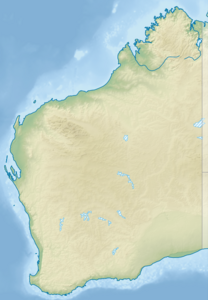Mount Augustus
| Mount Augustus | ||
|---|---|---|
|
Mount Augustus from the north northeast |
||
| height | 1106 m | |
| location | Western Australia , Australia | |
| Coordinates | 24 ° 19 ′ 30 ″ S , 116 ° 50 ′ 30 ″ E | |
|
|
||
| Type | Inselberg | |
| rock | mostly sandstone | |
| Age of the rock |
Mesoproterozoic (1.8-1.6 billion years ago) |
|
The Mount Augustus is an island mountain in the northwest of Australia . He is the namesake of Mount Augustus National Park . The Aborigines call it Burringurrah . Paintings and engravings of them have been preserved in several places on the mountain. The surrounding vegetation consists of tall mulga bushes and other acacias .
geography
Mount Augustus is located in the northwest of the state of Western Australia about 850 km north of Perth and 320 km east of the city of Carnarvon . From Carnarvon the road runs 195 km east to Gascoyne Junction. Then turn north in front of "Warri Well" and after a 124 km drive you will reach Mount Augustus.
Mount Augustus is eight kilometers long and three kilometers wide. Its longitudinal axis runs roughly northwest-southeast. The mountain has a height of 1,106 m and rises over 600 m in relation to the surroundings. It has a volume 2.5 times as large as the much better known Uluṟu ( Ayers Rock ). The rock color varies between purple, pink, red and orange and the appearance of the mountain from a distance depends on the weather and the position of the sun, similar to Uluṟu.
Geology and geomorphology
The mountain is an erosion residue, which is mainly composed of a sequence of light mesoproterozoic (approx. 1.6 billion years ago ) quartz sandstones and subordinate quartz conglomerates . This sequence is named after the mountain Mount Augustus sandstone . The Mount Augustus sandstone is the oldest succession of unmetamorphic Proterozoic sedimentary rocks in the region. It overlays discordantly older mesoproterozoic metamorphic and igneous rocks ( chlorite - muscovite slate or biotite granite ). The entire rock complex is folded and forms a saddle ( anticline ) with the metamorphites and magmatites in the core. The age of the folding is given as 1 billion years. The saddle axis strokes northwest-southeast, which suggests that the shape of the mountain goes back to the saddle structure. Metamorphic and igneous rocks only bite out in a relatively small area in the northwest of the mountain called The Pound .
Mount Augustus is sometimes referred to in current geological literature as the "largest monolith in Australia". However, the mountain consists of more than one type of rock and therefore cannot be a monolith in the literal sense. In addition, “monolith” is a poorly defined term that has been applied and is still used today to a large number of compact structures with larger dimensions, natural and artificial. Its value as a geomorphological term is therefore very limited, which is why isolated, compact mountains should not be referred to as monoliths, even if they consist entirely of the same rock.
history
On June 3, 1858, Francis Thomas Gregory was the first European to climb the mountain. A few weeks later he named the mountain after his brother Sir Augustus Charles Gregory .
Individual evidence
- ↑ Complete paragraph after Robert P. Bourman, Cliff D. Ollier, Solomon Buckman: Mount Augustus Geology and Geomorphology. Geographical Research. Vol. 48, No. 2, 2010, pp. 111–122, doi : 10.1111 / j.1745-5871.2009.00608.x (alternative full text access : ResearchGate )
- ↑ Robert P. Bourman, Clifford D. Ollier, Solomon Buckman: Inselbergs and monoliths: a comparative review of two iconic Australian landforms, Uluru (Ayers Rock) and Burringurrah (Mount Augustus). Journal of Geomorphology. Vol. 59, No. 2, 2015, pp. 197–227, doi : 10.1127 / 0372-8854 / 2014/0148 , (alternative full text access : ResearchGate ).

